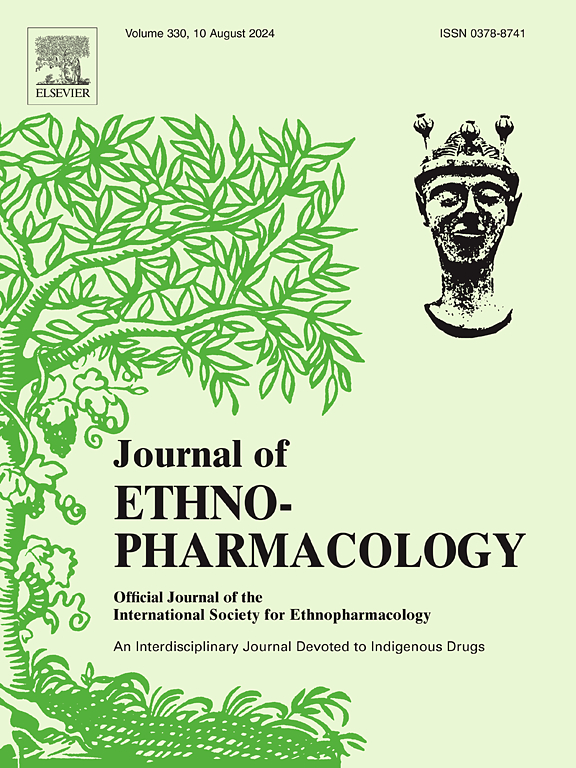洋甘菊叶和花提取物通过调节胆碱能功能障碍和大脑抗氧化状态改善东莨菪碱诱导的健忘症:一项体内和计算机研究。
IF 5.4
2区 医学
Q1 CHEMISTRY, MEDICINAL
引用次数: 0
摘要
民族药理学相关性:洋甘菊(M. Chamomilla L. flowers, Family: Asteraceae)是西亚和欧洲著名的民间药物。传统上,它被用来镇静神经,促进睡眠,缓解消化问题,如胃痉挛和腹泻。尽管如此,研究表明其叶提取物还具有增强记忆和抗氧化的特性。研究目的:本研究旨在证明洋甘菊叶和花的水酒精提取物可能通过发挥神经保护作用来调节东莨菪碱诱导的遗忘大鼠模型的记忆。材料与方法:给药21 d,分别给予大鼠叶提取物和花提取物的水酒精提取物(200和300 mg/kg / d),同时在给药前30分钟腹腔注射氢溴酸东莨菪碱(1 mg/kg),造成大鼠记忆损伤。首先对提取物的总黄酮、多酚含量进行GC-MS分析。对抗氧化和MTT测定也进行了定量。采用被动回避、开阔场地、固定棒、旋转棒和水迷宫测试进行记忆和运动评估。测定大鼠脑内乙酰胆碱酯酶和乙酰胆碱酯酶活性及组织病理学变化。测定大鼠脑内抗炎生物标志物总量及谷胱甘肽过氧化物酶、c反应蛋白、超氧化物歧化酶水平。最后,通过硅基分子对接的方法预测了部分鉴定的化合物与乙酰胆碱酯受体的结合亲和力。结果:我们的研究结果表明,与东莨菪碱组相比,洋甘菊叶和花提取物中含有60种化合物,叶提取物中含有70种化合物,具有显著的恢复记忆障碍和运动能力的作用。这两种提取物均能显著逆转东莨菪碱引起的大鼠大脑氧化-抗氧化平衡、乙酰胆碱和乙酰胆碱酯酶活性的变化(结论:因此,实验和体内结果表明,洋甘菊叶和花提取物可能通过增强胆碱能系统和抗氧化活性而有效地治疗记忆丧失。本文章由计算机程序翻译,如有差异,请以英文原文为准。

Matricaria chamomilla L. leaf and flower extracts improved scopolamine-induced amnesia via regulation of cholinergic dysfunction and brain antioxidant status: An in-vivo and in-silico study
Ethnopharmacological relevance
Chamomile (M. Chamomilla L. flowers, Family: Asteraceae) is a notable folk medicine in western Asia and Europe. It has traditionally been used to calm the nerves, induce sleep, and relieve digestive issues like stomach cramps and diarrhea. Nonetheless, studies suggest that its leaf extract also possesses memory-enhancing and antioxidant characteristics.
Aim of the study
The present study aimed to provide evidence showing that the hydroalcoholic extracts of M. Chamomilla L. leaf and flower may regulate memory in a scopolamine-induced amnestic rat model via exerting neuroprotective effects.
Materials and methods
For 21 days, rats were given hydroalcoholic extracts of the leaf and flower extracts (200 and 300 mg/kg per day) orally, while scopolamine hydrobromide (1 mg/kg) was administered intraperitoneally, 30 min before the treatment to cause memory impairment. Initially, the extract's total flavonoid, polyphenolic content, and GC-MS analysis were carried out. The antioxidant and MTT assay testing were also quantified. Passive avoidance, open field, stationary rod, rotarod, and water maze tests were employed for memory and locomotor assessment. In the rat's brain, ACh and AChE activity were assessed along with histopathological changes. The total amount of anti-inflammatory biomarkers in the rat brain and the levels of glutathione peroxidase, C-reactive protein, and superoxide dismutase were measured. And at last, predict the binding affinity of some identified compounds with the AChE receptor by In-silico molecular docking.
Results
Our results showed that M. Chamomilla L. leaf and flower extracts have 60 compounds in the flower extract and 70 compounds in the leaf extract, which significantly restored memory impairment and locomotor activities as compared to the scopolamine group. Treatment with both extracts significantly reversed not only scopolamine-induced changes in the oxidative-antioxidative balance, acetylcholine and acetylcholinesterase activity in the rat's brain (P<0.05). Moreover, we have found that the flower and leaf extract significantly reduced IL-1β and TNF-α expression in the rat's brain and restored scopolamine-induced histopathological distortion. The molecular docking analysis revealed a high probability of AChE inhibition by the identified compounds in the extracts.
Conclusion
Thus, In-silico and In-vivo results suggest that M. Chamomilla L. leaf and flower extracts may be an effective neuropharmacological treatment for memory loss by enhancing the cholinergic system and antioxidant activities.
求助全文
通过发布文献求助,成功后即可免费获取论文全文。
去求助
来源期刊

Journal of ethnopharmacology
医学-全科医学与补充医学
CiteScore
10.30
自引率
5.60%
发文量
967
审稿时长
77 days
期刊介绍:
The Journal of Ethnopharmacology is dedicated to the exchange of information and understandings about people''s use of plants, fungi, animals, microorganisms and minerals and their biological and pharmacological effects based on the principles established through international conventions. Early people confronted with illness and disease, discovered a wealth of useful therapeutic agents in the plant and animal kingdoms. The empirical knowledge of these medicinal substances and their toxic potential was passed on by oral tradition and sometimes recorded in herbals and other texts on materia medica. Many valuable drugs of today (e.g., atropine, ephedrine, tubocurarine, digoxin, reserpine) came into use through the study of indigenous remedies. Chemists continue to use plant-derived drugs (e.g., morphine, taxol, physostigmine, quinidine, emetine) as prototypes in their attempts to develop more effective and less toxic medicinals.
 求助内容:
求助内容: 应助结果提醒方式:
应助结果提醒方式:


